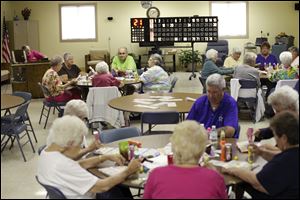
Oregon senior center levy funds studied
Transportation, health programs, assistance with household chores proposed
1/27/2014
Dozens play bingo at the Oregon Senior Center. Programs helping seniors understand benefits, manage health problems, and get more exercise are under consideration with new levy funds.
Oregon’s half-mill tax for senior services just took effect Jan. 1, but city officials already have begun to plan to spend the levy revenue.
Last week, they heard from representatives of organizations that provide senior services and decided a committee should be formed to make recommendations.
The committee will be composed of a representative from Mayor Mike Seferian’s administration and city council’s three-member recreation and parks committee: Joshua Hughes, Dennis Walendzak, and chairman Terry Reeves. The panel will help establish priorities for allocating roughly $215,000 per year that the five-year levy will generate.
The senior levy passed Nov. 5 with more than 53 percent of the vote. Council approved putting the measure on the ballot last year after hearing from members of Oregon’s own senior center on Bayshore Road, although some were skeptical of its chances for success. Members of the senior center, officially called the James “Wes” Hancock Senior Center, then spearheaded the successful levy campaign.
The center is in a rent-free, city-owned building that used to be a sewer plant lift station. But levy funds, Mayor Seferian explained, “don’t have to be disbursed through the Hancock senior center, and could be done through other outlets.”
Oregon Administrator Mike Beazley described last week’s recreation and parks committee meeting as “a first step” in the process of collecting information about services levy money can and should provide. Agencies represented were the Area Office on Aging, the YMCA and JCC of Greater Toledo, and the Oregon senior center.
Justin Moor, the AOA’s vice president, came with local survey results from 2010 listing services seniors said they needed most: benefits counseling, home delivery of meals, help with bathing and dressing, transportation, minor home repair, and household chores.
Since the survey was done, additional services bridging health care and social services had become popular, Mr. Moor said. They were: tai chi to improve balance and reduce falls, diabetes self-management, chronic pain self-management, and the Healthy You program.
“This is the Top 10 list of best practices,” he told Oregon officials. Collette Cordova, his colleague at the senior agency, added that adult day care was a growing need, with 50 percent of seniors older than 85 having some form of dementia.
Mayor Seferian said only 20 to 25 of the 600 people surveyed were Oregon residents, so while the survey was “a good starting point,” he did not feel it was an adequate sample to assess Oregon seniors’ needs.
Melanie Grohowski, who runs the Eastern Community YMCA, said 650 Oregon seniors use that branch, which offers many of the services Mr. Moor mentioned — and “we’re always looking to partner.” She cited activities such as pickleball her Y would like to offer.
Paula Benton, director of the Oregon senior center, said her center’s 14-passenger van does “as many transports as we can in a day,” and the center could use another van or two to satisfy demand. But Mayor Seferian said buying two vehicles was out of the question.